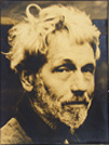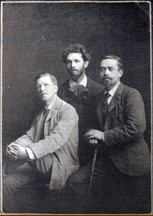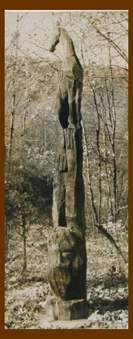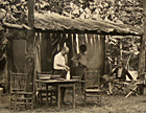HERVEY WHITE AND THE MAVERICK ART COLONY THE JEAN GAEDE AND FRITZI STRIEBEL ARCHIVE CENTER FOR PHOTOGRAPHY AT WOODSTOCK
|
Hervey White and the Maverick Art Colony An Historical Overview Hervey White, writer, socialist, social reformer, and above all idealist, was born on a prairie farm in New London, Iowa, in 1866. He worked his way through the University of Kansas for two years and took part in a scientific expedition in the mountains of Mexico. Through connections he was able to transfer to Harvard University, where, in spite of crushing poverty, he managed to complete his B. A. degree in 1894. Following his graduation from Harvard, White trekked around Europe and found himself increasingly drawn to the movements for social reform that he encountered in his travels. In particular, the settlement house movement made a deep impression on him. This arose in England in the 1880s in response to the appalling social conditions that accompanied industrial poverty. Educated individuals “settled” in communal houses in impoverished neighborhoods and advocated for social reform through educational programs that included the arts, which were believed to uplift the spirit. Eager to advocate for the underclasses White took a position at Hull House, a settlement house in Chicago founded by the social reformer Jane Addams to educate the struggling immigrant population of Chicago's West Side. She was the first to appreciate the work of immigrant artisans and musicians, encouraging them to express their ethnicity through the arts. During his four years at Hull House, White wrote prolifically, and his first novel Differences, which reflected his experiences at Hull House, was published in 1899. His second novel Quicksand (1900) was applauded by Theodore Dreiser as one of six great American novels. A book of short stories When Eve Was Not Created and Other Stories was published a year later, and Noll and the Faries came out in 1902. It was within the environment of Hull House that White became acutely aware of the economic problems that impeded the creative development of talented young people, and he resolved to create an ideal environment that would allow writers, musicians, and artists to freely explore their creative potential without overwhelming financial pressures. It was also at Hull House that he met the Swedish painter and philosopher Carl Eric Lindin, who enthusiastically shared his views. They became life-long friends. While at Hull House White also enjoyed the friendship of dissident intellectuals and educational and social reformers, such as the feminist Charlotte Perkins Gilman. It was she who introduced White to the Englishman Ralph Radcliffe Whitehead in the late 1890s in Chicago. Whitehead was planning the establishment of a utopian arts and crafts colony in the United States. As a follower of the English philosopher John Ruskin and the painter and socialist William Morris, Whitehead believed that creative manual labor and personal expression through arts and crafts was the most effective way of dispelling the mind-numbing dehumanization of the Machine Age that had gripped the working classes. He had already established an arts and crafts school for lower class children on his estate in Santa Barbara, California, and was intent on expanding his vision to a larger adult population. Whitehead believed he had found a kindred spirit in Hervey White and invited him and the painter Bolton Brown to join in the venture of founding a utopian arts and crafts colony. It was in fact Brown who convinced Ralph Whitehead and Hervey White that the landscape of the Catskills provided the perfect environment for such a colony. Thus, in 1902, Whitehead purchased 1500 acres below the face of Overlook Mountain in Woodstock and entrusted the management of the colony to Hervey White, Carl Eric Lindin, and another friend Frits van der Loo. Whitehead called it Byrdcliffe, combining the middle name of his wife Jane Byrd McCall with his middle name Radcliffe. Houses, studios, and workshops were built and artists were engaged as teachers to a younger generation. One of these younger artists was Vivian Bevans, a printmaker from Chicago. She and White fell in love and were married in 1903. Shortly after the establishment of Byrdcliffe Hervey White began to be disillusioned with what he perceived to be an overly-structured environment that hindered rather than fostered free creativity. He left Byrdcliffe in 1905 and together with Frits van der Loo purchased a large farm on the south slope of Ohayo Mountain in Hurley's Patentee Woods. Although at first the farm was a merely a summer haven for White, his wife, and White's socialist intellectual friends, it quickly expanded to conform to White's singular vision of a utopian community, where creative freedom could thrive in an environment of rustic simplicity. The farm eventually became known as the Maverick Art Colony. An enduring symbol of the colony was a tall wood sculpture of a wild horse made by John Bernard Flannagan in 1924 that stood at the entrance to the colony, as if to underscore its maverick nature. Bolton Brown later was to characterize the colony as "a state of mind." Thus began White's utopian experiment that outlived Byrdcliffe as it originally was conceived and lasted until White's death in 1944. Writers, musicians, and artists were quick to respond to White's invitation to pass the summer in a rustic house in the beauty of the Catskills for minimal rent, or often no rent at all. If a house was not available he would build one. By 1910 for White and some other residents the Maverick was home year round. The colony had few rules, but under White's influence a strong communal spirit was developed. Despite this, White's wife Vivian Bevans was unhappy and left the colony with their two small sons, never to return. Life at the Maverick was very rustic and there were few amenities. Some of the houses were little more than shacks, or even less, as in the case of the Mosquito House, so-called because it consisted of nothing but a rustic framework around which was hung mosquito netting. White believed that simplicity was the main component of a creative environment and he was reluctant to complicate that environment with modern conveniences. Money and physical comforts were always in short supply, but this never dampened the enthusiasm of the residents. In 1915 when a well was needed to supply water to the rapidly growing colony, White instituted the Maverick Festival at the suggestion of resident musicians so that funds could be raised for the digging of the well. White saw this as an opportunity to unify the disparate factions in Woodstock in a grand celebration of pageantry and revel. In 1916, also at the suggestion of musicians, White founded the Maverick Sunday Concert Series and built the Maverick Music Hall that still houses the Sunday Concert Series to the present day. In order to provide food for guests, as well as residents, the Intelligencia Cafe was opened on the grounds, and in 1924 the Maverick Theater was built for productions that often were staged by well-known directors. In 1910 White founded the Maverick Press and began publishing the monthly journal The Wild Hawk (1911-1916), superceded by Plowshare (1916-1935), as well as the The Hue and Cry (1923 - 1929), which described itself as “a record of the achievements, artistic and literary of the Woodstock colony.” In 1938 White turned the press over to James Cooney, who began publication of The Phoenix, a journal of dissident ideas. The annual Maverick Festival was the main source of income for the colony and provided funds for the building and maintenance of the colony's houses. However, in 1931 White was compelled to suspend the Festival because of forces beyond his control, and a major blow was dealt to the finances of the colony and well as to his dream of a celebration of unity. However, White continued to struggle to keep the colony vibrant, and artists feeling the effects of the Great Depression found a welcome haven at the Maverick. Projects were begun in an attempt to infuse new life into the colony, but it was as if the creative energies of the colony itself were spent. With the passing of each year and the decline of his own energies, White found the harsh Catskill winters increasingly difficult to tolerate, although he continued to find great comfort in the Maverick community. In the late 1930s White bought a small farm in south Georgia, where he spent the winters, and where he organized a theatrical production using local black talent. Returning to the Maverick every Spring, he never tired of welcoming new artists, or of hearing the news from the established residents. On October 20, 1944 Hervey White passed away, it is said in his sleep, in his cabin called "6 x 8" that he had lived in during the summers for the final years of his life.
|
|





